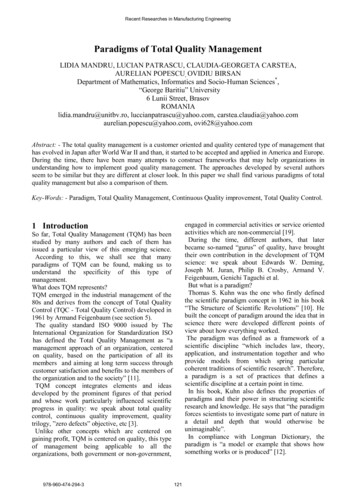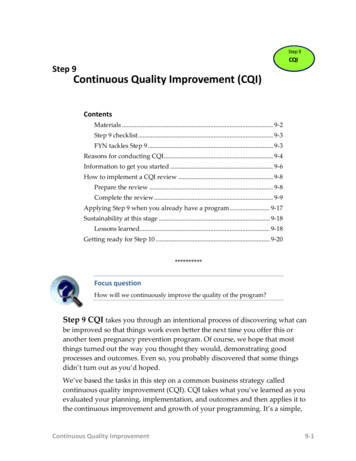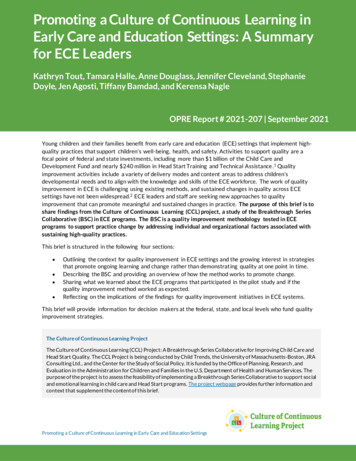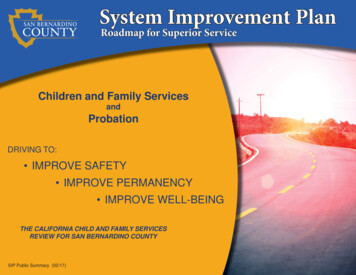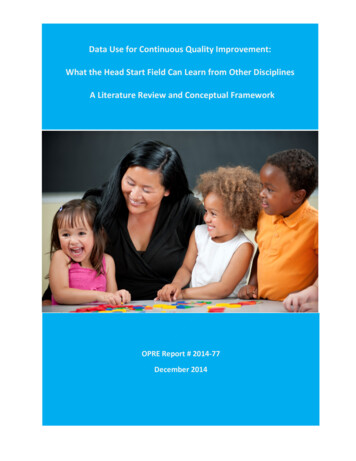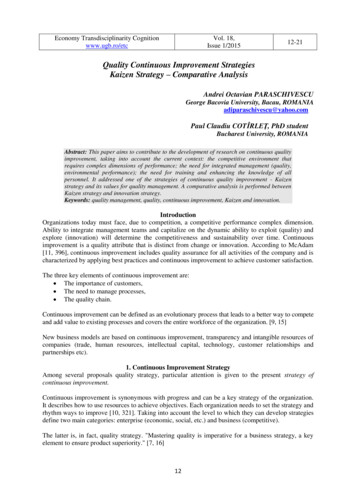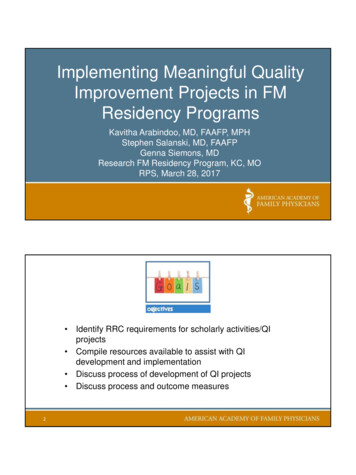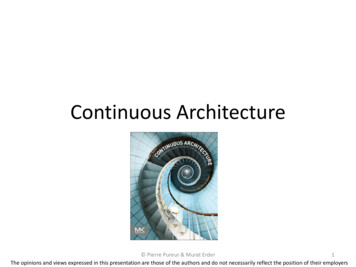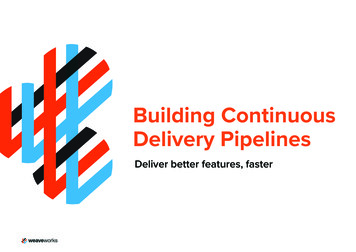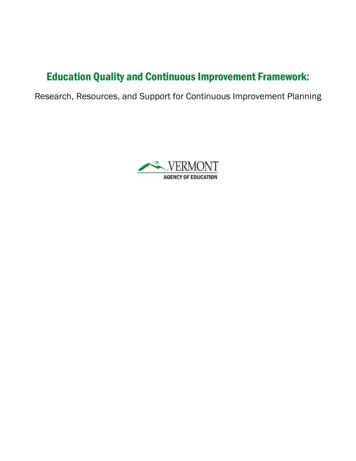
Transcription
Education Quality and Continuous Improvement Framework:Research, Resources, and Support for Continuous Improvement Planning
Table of ContentsExecutive Summary . 3Agency of Education Theory of Action for Continuous Improvement . 3Who Should Use This Framework? . 31.0 Continuous Improvement Planning. 41.1 Approach to Continuous Improvement . 41.2 District and School-Based Plans. 51.3 Support for Continuous Improvement Planning . 5Building Capacity and Culture for Continuous Improvement . 5Actions for Building Capacity and Culture . 7Guiding Questions for Building Capacity and Culture . 7Resources for Building Capacity and Culture . 7Phase 1: Assess and Innovate . 7Actions for Phase 1 . 7Guiding Questions for Phase 1 . 8Resources for Phase 1 . 9Phase 2: Test and Pilot . 9Actions for Phase 2 . 10Plan and test changes for improvement on a small scale: . 10Guiding Questions for Phase 2 . 11Resources for Phase 2 . 11Phase 3: Implement and Spread . 11Actions for Phase 3 . 12Guiding Questions for Phase 3 . 12Resources for Phase 3 . 12Phase 4: Sustain . 13Actions for Phase 4 . 13Guiding Questions for Phase 4 . 13Resources for Phase 4 . 132.0 Research Support for Quality Instruction and Continuous Improvement . 142.1 Supporting Research . 142.2 Statewide Support System for Continuous Improvement . 15References . 18Appendix A: Continuous Improvement Plan . 21Appendix B: Sample Continuous Improvement Plan . 22Appendix C: Organizing for Continuous Improvement (Optional Checklist) . 23Appendix D: Additional Continuous Improvement Planning Resources by Topic . 26Appendix E: Case Studies for Test and Pilot Phase PDSA Cycles. 27Appendix F: PDSA Worksheet . 30Appendix G: Directions and Criteria for Federal Program Grant Applications . 32Education Quality and Continuous Improvement FrameworkRevised: May 28, 2020Page 2 of 33
Executive SummaryAgency of Education Theory of Action for Continuous ImprovementIf the AOE is fully committed to continuous improvement for Vermont Education Quality Standards andEvery Student Succeeds Act expectations, then, we will operate from a shared vision and collectiveresponsibility, and apply a systemic approach to continuous improvement by: using quantitative and qualitative data, evidence, research, and current technology for ongoingassessment and evaluation of the efficacy of our work; co-operating and collaborating across divisions on projects, professional projects, policy developmentand implementation efforts, and field technical assistance and professional learning; applying a project-management approach to strategically plan and adapt our work to meet thechanging needs of the field; engaging in partnerships with community members, families, institutes of higher education, othergovernmental agencies, and other relevant stakeholders; supporting school systems through consistent and transparent messaging, useful and timely resources,and differentiated coaching or professional learning for improvement efforts; and ultimately helping educators improve achievement and well-being for ALL Vermont learnersSo that we may assist school systems with their efforts in continuous improvement, the Education QualityAssurance Team—in collaboration with other AOE teams—has synthesized prominent field research andassembled a collection of actions, guiding questions, resources, research summaries, and supports for VermontLEAs and school systems. This document is the result of our efforts. It includes a framework for deliveringquality education and for continuously improving educational practices and processes with the ultimate goalof providing equitable and quality education to all Vermont learners. The framework will be updated asneeded.Who Should Use This Framework?The framework is designed to provide resources, information, and strategies for continuous improvement.Appropriate users of this guide will be familiar with the term “continuous improvement,” have knowledgeabout the data that school systems are required to collect, and have some understanding of how to use data ina service delivery or management setting.Technical assistance staff or consultants may find the Comprehensive Needs Assessment Toolkit a helpfulresource for working with leaders at the LEA and/or school levels who are trying to build a learning culture,using data to improve program quality and equity, or need suggestions about ways to involve staff in datause. Educational leaders and individuals attempting to promote data use may find the comprehensive needsassessment a helpful process for providing examples and tips to staff about the benefits of data analysis,involving more staff in data inquiry, and thinking about how to make time for data inquiry and use.It is recommended that users read through the entire framework to decide which parts are most useful to theirorganization or situation. The tools and resources throughout may be used separately, but the peopleintroducing them to others should have the framework background, to be sure they are appropriatelyapplying the processes in continuous improvement. Guiding questions are embedded throughout theEducation Quality and Continuous Improvement FrameworkRevised: May 28, 2020Page 3 of 33
document. These questions are intended for those engaged in the work of continuous improvement—at theSEA, LEA, or school-level. A Continuous Improvement Plan Template is included in the Appendices section.1.0 Continuous Improvement Planning1.1 Approach to Continuous ImprovementBuilding capacity for improvement relies on strong relationships between improvement at the school, district,and regional level (Hatch, 2013). For most teams at the Agency of Education, the intent is to build capacity forcontinuous improvement at the supervisory union/district level, rather than focusing innovation andimprovement exclusively on a select group of schools. In order to assist supervisory unions/districts in helpingtheir schools improve, the Education Quality Assurance Team is adopting an improvement scienceapproach—and a corresponding theory of action—for supporting Vermont school systems.Improvement science is an approach for improving quality and productivity in diverse settings, producingknowledge about what works, for whom, in which circumstances (Cohen-Vogel, Wagner, Allen, Harrison,Kainz, Socol, & Wang, 2015). It is a form of study that applies research methods to better understand themethods, theories, and factors that facilitate or impede quality improvement (Health Foundation, 2011). Ineducation, this approach involves the disciplined use of evidence-based methods to improve systemiceffectiveness, which includes studying problems of practice and their underlying systems and processes(Herrera, 2016). To achieve education quality and sustain continuous improvement educational systems mustdetermine what works among diverse educators teaching varied populations of students in varyingorganizational contexts (Bryk, 2015). Correspondingly, in this framework for continuous improvement,supervisory unions/districts and school systems determine problems of practice, apply appropriate changes. Inorder for quality improvement to be continuous, it must be ongoing, and infused into the daily work thatindividuals are doing throughout the system (Park, Hironaka, Carver, and Nordstrum, 2013). In contrast to anexternal accountability motive, a continuous, quality improvement approach involves connecting systemicprocess/practices and outcomes; focusing on problems of practice; contextualizing solutions; and focusing oninternal accountability among all members of the organization as a primary driver of improvement (O’Day andSmith, 2016). When applying methodologies congruent with improvement science, such as Lean, Six Sigma,Implementation Science and Plan-Do-Study-Act cycles of learning, the underlying philosophy is that allprocesses can be continually improved (e.g., LeMahieu, Nordstrum, and Greco, 2017). Such approaches areaimed at preventing the trend in which highly rated schools become complacent, while low performers may bediscouraged from getting the nuanced data they need to improve.As a comprehensive approach to continuous improvement, improvement science principles are congruentwith the ongoing efforts in which many Vermont schools are engaged, such as implementation science. Byadopting an improvement science approach, school systems can apply Plan-Do-Study-Act (PDSA) cycles toinnovate, test, review, and revise improvement strategies (e.g., Deming, 1993; Langley et al., 2009). The PDSAcycle is a scientific method for making hypotheses about the efficacy of proposed solutions on standard work,processes and outcomes (LeMahieu, Nordstrum, and Greco, 2017). These cycles are customized for thepurposes of piloting innovations or interventions (in the pilot phase of improvement), as well as fullyembedding the change into the standard work of the system (during the implementation phase). The Institutefor Healthcare Improvement, which has been contributing to the knowledge base for many years, offers a sideby side illustration of the practices unique to each and common to both.Education Quality and Continuous Improvement FrameworkRevised: May 28, 2020Page 4 of 33
1.2 District and School-Based PlansAs indicated in the Education Quality Standards, Supervisory Unions and Districts are required tosubmit a continuous improvement plan to highlight broad priorities and goals at the LEA level. Eachschool is required to submit a continuous improvement plan reflecting school-based improvementefforts, which are congruent to LEA priorities. Although school-based plans will reflect problems ofpractice and variations specific to each context, these plans should also be aligned with SU/SD levelpriorities and initiatives, based on the SU/SD level needs assessment. Schools and SUs/SDs shouldconduct/revise needs assessments at least yearly and make adjustments to change ideas accordingly.Figure 4 illustrates the parallel nature of these plans. A sample plan is included in Appendix B and theContinuous Improvement Plan Template is located in Appendix A.Figure 4: Supervisory Union/District Plans and School-Based Plans1.3 Support for Continuous Improvement PlanningBuilding Capacity and Culture for Continuous ImprovementOrganizations must build the capacity and the culture for continuous improvement to become part of theirembedded practices. A continuous improvement culture requires a commitment to ongoing collaborativeinquiry with multiple sources of data to ensure internal accountability. Appropriate structures and practicesmust be in place to foster this commitment. The purpose of the continuous improvement process is to usecycles of learning to monitor and document the impact of strategic improvement actions/changes.Improvement decisions should be based on data-driven needs assessments oard-rules-series-2000. In collaboration with other AOEteams, the Education Quality Assurance Team will apply a state support plan for coaching LEA’s incontinuous improvement. This plan focuses on six improvement principles recommended by Bryk, Gomez,Grunow, and LeMahieu (2015):Education Quality and Continuous Improvement FrameworkRevised: May 28, 2020Page 5 of 33
1.Making the work problem-specific and user-centered2.Focusing on variation in performance3.Understanding the system that produces the current outcomes4.Examining relevant measures for improvement5.Using disciplined inquiry6.Accelerating learning through networkingThese principles are the foundation for problem-solving, along with considering three fundamental questions,based on the work of Langley, Moen, Nolan, Nolan, Norman, and Provost (2009)1. What are we trying to accomplish?2. How will we know when a change is an improvement?3. What change can we make that will result in an improvement?The principles of improvement science apply to the entire scope of the continuous improvement process (fromplanning and piloting to implementation and spread). Figure 1 illustrates the phases of the continuousimprovement process, as well as where PDSA cycles might occur throughout the process. A ContinuousImprovement Plan Template is located in Appendix A.Figure 1: Phases of the Continuous Improvement ProcessEducation Quality and Continuous Improvement FrameworkRevised: May 28, 2020Page 6 of 33
The subsequent pages include actions, guiding questions, and resources for each phase of continuousimprovement planning. Actions: During each phase there are specific actions that school systems will execute Guiding Questions: Suggested questions to shape effective work Resources: Tools that can support school systems during each phase of workActions for Building Capacity and CultureOrganizing for Continuous Improvement (Optional Checklist)Develop an understanding of the improvement principles, the three fundamental improvement questions, and theBuild knowledge of PDSA cycles of improvementGuiding Questions for Building Capacity and Culture Guiding questions are embedded in the checklist and framework in the above actions section.Resources for Building Capacity and Culture Organizational Conditions for Continuous ImprovementA Culture of Continuous ImprovementThe 6 Core Principles of ImprovementPhase 1: Assess and InnovateKey to any form of improvement planning is a comprehensive needs assessment. A comprehensive needsassessment is a type of structured decision-making and serves as the initial phase in continuous improvementplanning. This self-assessment process is intended to promote a culture of reflection, collaborative inquiry,deep learning, and shared responsibility for continuous improvement at the school and LEA level. The needsassessment considers a range of needs and problems of practice. During this process, school systems exploreassumptions about problems of practice by analyzing data from multiple sources, considering the beliefs andpractices that are problematic (Mintrop, 2016). During a needs assessment, consider the following components:a shared vision; representation from stakeholders; broad areas of focus; identified problems of practice androot causes; and a theory of action. Underlying the entire process is a strong commitment to collecting andanalyzing multiple sources of data and making informed, collective decisions based on these analyses.Actions for Phase 1Conduct Needs Assessment: The following list includes the component parts of the needs assessment:A. Shared Vision: In developing or strengthening the vision, teachers, families, and community memberscollectively talk about their desires for students and community, thinking and acting, “with the powerthey already have, about the things that are important to them.” (Senge, Cambron-McCabe, Lucas,Smith, Dutton, and Kleiner, 2000).B. Collaborative Stakeholders Represented: The needs assessment team should include necessary and diversestakeholders representing all parts of the system, including school board members, students, familiesand community members.C. Broad Area(s) of Focus Based on Data Review: Describe the broad area(s) of focus, directly related to longterm goals and the 5 component areas of EQS (Academic Proficiency; Personalization; High QualityStaffing; Safe, Healthy Schools; and Financial Efficiencies). Describe your current state and your goalstate for your broad areas of focus.Education Quality and Continuous Improvement FrameworkRevised: May 28, 2020Page 7 of 33
D. Identify Priority Problems/Problems of Practice: Based on the identified broad focus areas, dig deeper intothe data to determine the focused, learner-centered, prioritized problems for which you intend to seekinnovative solutions/interventions to reach your goal state.E. Root Cause Analysis Results: Provide a brief narrative describing the results of your root cause analysisfor prioritized problems; include the major factors contributing to each problem.F. Theory of Improvement/Action: Based on your needs assessment results, data analysis, and researchsupport, define your theory of improvement/action for this goal. A working theory of improvementincludes a well-specified goal and a working theory of high-leverage change that we believe will leadto that goal. A driver diagram is an improvement tool used to visualize communicate that theory. Itrepresents the shared theory of improvement, building upon knowledge gained from research,observation and experience. The drivers identify the elements in the system that are necessary andsufficient for achieving intended goals (Bennett and Provost, 2015). The diagram contains informationabout the problem of practice, intended goals, primary (and optionally secondary) drivers, and theagreed upon change ideas that are predicted to improve the system; it should be dynamic and changeas new evidence is collected. A good theory of improvement/action: focuses efforts on the highestleverage parts of the system; is collectively owned by those engaged in the improvement efforts; and isrevised as needed.G. Determine Ideas for Change: Assess and understand current state of organizational performance; analyzedata; Identify gaps between current and goal state; access the knowledge base/conduct research;identify potential evidence-based strategies, establish goals, measures, strategic objectives and actionsthat support core priorities. Address the overarching questions: What do we want to accomplish? Describe prioritized Goal(s). Focus on changes that alter standardwork/processes. Be sure they are student-centered, measurable, and meaningful to your work andyour context. What change can we make that will be an improvement? Plan and describe your evidence-basedactions for improvement. Focus on high-leverage changes that affect the standard work/processeswithin your context. These include systemic changes that may fundamentally improve performanceacross classrooms and school systems. Your changes should be detailed enough to test during youriterative cycles of learning. How will we know when a change is an improvement? In specific terms, describe the measuresand specific data you will use to determine results and successGuiding Questions for Phase 1 Are current strategies, tactics, and behaviors consistent with the current mission, core beliefs, and corevalues?What elements are easy to see and confirm their presence in the building?Which elements are not visible and require investigation to confirm their presence?If the building were observed for days, where would the vision have been seen in action?What might be observed that could be considered incongruent with the vision?How do we understand the problem(s)? What are we trying to accomplish? What do we know about our current situation? What are the user experiences (e.g., interviews, surveys)? What information do we have available? What trends and issues do the data reveal?Education Quality and Continuous Improvement FrameworkRevised: May 28, 2020Page 8 of 33
What would success look like? Based on our data overview, what are our systemic strengths and areas of focus? Focal areas aredirectly related to EQS components and state long-term goals.What changes can we make that will result in an improvement? How will we know that our change is an improvement? What will success look like? How will it be measured? What is the relationship between your change ideas and your goals/outcomes (Drivers Diagram)? What are your assets, needs, and drivers (elements necessary and sufficient for the intended goal)? What strategic actions must we take related to these changes? Why? What research/data are we using to justify these decisions? What evidence-based processes, curriculum, pedagogy, and assessments align with our plans? What impacts do we expect and by which criteria we will measure impact?How will we monitor progress along the way?Resources for Phase 1 Six Improvement PrincipalsData Wise Process and Free Online CourseUsing Driver Diagrams to Build a Theory of Improvement/ActionDriver Diagram TemplateThe Data Informed District: Research on Using Data to Inform PracticeImprovement Science Tools from High-Tech High Graduate School of EducationPhase 2: Test and PilotThis phase involves planning and testing the agreed upon changes for improvement; these changes should bedirectly related to needs assessments, the Education Quality Standards, and the three overarching questions: What do we want to accomplish? What change can we make that will be an improvement? How will we know when a change is an improvement?Figure 2 depicts the PDSA improvement cycle for this pilot/testing phase of the improvement process. ThesePDSA cycles are analogous to mini-experiments during which educators articulate improvement changes,carry out the change, study the results, and act decide how to proceed (e.g., adopt the change, adapt thechange, or abandon the change). The overall arch of this phase is an improvement investigation in whicheducators learn quickly and affordably which interventions work and, later, how to adaptively integrate themto attain quality outcomes reliably at scale (Bryk, Gomez, Grunow, and LeMahieu, 2015).Education Quality and Continuous Improvement FrameworkRevised: May 28, 2020Page 9 of 33
Figure 2: PDSAImprovement Cycle forTest/Pilot PhasePlan Review goals (connected to EQS) and determine change ideas that will most impact student learningExplicate improvement hypothesis, plan how you will test the selected/designed change (withsupporting research and evidence), and determine how you will measure impact of the plannedchanges.Do Test your planned change.Collect data, and document progress.Study Analyze data and measure against goals and predictions Summarize learning and determine necessary revisions.Act Adapt, adopt, or abandon the change, in response to data and evidence gathered through dataanalysis/monitoring/reviews.Plan for the next cycle (or move to implementation phase, if ready)Actions for Phase 2Plan and test changes for improvement on a small scale: Apply PDSA iterative cycles to ensure efficacy for implementation; these tests should reflect the maincause and effect relationships reflected in the driver diagram. Align action at all levels of the organization. Educate and train staff. Communicate information/expectations. Embed appropriate professional learning. Collect relevant data (e.g., assessments, surveys, interviews, and observations of instructional practice)that will assist during the next phase of the cycle. Monitor progress and evaluate results; explain how you monitored the progress of your change againstyour goals and objectives. What can you conclude?Education Quality and Continuous Improvement FrameworkRevised: May 28, 2020Page 10 of 33
Adapt, adopt, or abandon your change and explain rationale for adaptation, adoption, orabandonment.Guiding Questions for Phase 2 How will we carry out our change idea? What resources and knowledge do we have/need? What professional learning needs to happen? How will we strengthen a collaborative culture for professional learning to build capacity for precisionin pedagogy and personalized learning, through coaching, modeling, partnerships, professionallearning communities, instructional rounds, lesson study, etc.? What systemic changes will we make in the following areas: instructional systems and practices;organizational and performance management routines; culture; staffing; scheduling; evaluationprocesses; professional learning; student safety and climate; and family and community engagement What do the data reveal? How did our strategic actions impact student achievement and well-being? What is working, forwhom, in which circumstances? Was the change an improvement? What is not working? Why? What adjustments may need to be made? How did our strategic actions impact student achievementand well-being? What is working, for whom, in which circumstances? Was the change an improvement? What is not working? Why? What adjustments may need to be made?Resources for Phase 2 Evidence-Based Actions for ImprovementEvidence-Based Improvement ToolsGuides for Identifying Evidence-Based Interventions for School ImprovementPDSA WorksheetDirections and Criteria for Federal Program Grant ApplicationsPhase 3: Implement and SpreadThis phase involves making plans and decisions for full implementation and for spreading the change acrossclassrooms and/or schools. Figure 3 depicts the steps in applying the PDSA cycle for effective implementation,fidelity of implementation, and for scaling up the innovation/change to additional settings. These steps aredescribed below.Education Quality and Continuous Improvement FrameworkRevised: May 28, 2020Page 11 of 33
Figure 3: PDSA Cycle forImplement and Spread PhasePlan identify barriers or challenges to full implementation; specify the plan to fully implement programs orinnovations in making them standard work/processes; specify monitoring methods and measurementsDo carry out the strategies or plan as specified to address the challenges,Study use the measures identified during the planning phase to assess and track progress and fidelity, andAct make changes to the next iteration of the plan to improve implementation an
The principles of improvement science apply to the entire scope of the continuous improvement process (from planning and piloting to implementation and spread). Figure 1 illustrates the phases of the continuous improvement process, as well as where PDSA cycles might occur throughout the process. A Continuous Improvement Plan Template is located in


